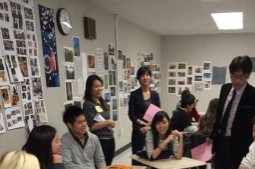
By Jennifer Trend
Maybe you’ve seen students you’ve never seen before milling around the school, speaking in a different language. Perhaps you’ve even had the chance to interact with them. Sometimes they’re in uniforms, and other times, they look just like us.
In reality, they’re Japanese and French students visiting Fountain Valley High School (FVHS) as part of their study abroad program. The Japanese students come as a group, while the French students come for a home stay experience. Meanwhile, Spanish has yet to host students from Spanish speaking countries, but there has been the occasional individual here and there.
Every year, multiple different companies contact Saori Tanaka, the Japanese teacher, for visits or shadowing opportunities. This year, a boys and girls school from Chiba will visit under the company Skyus, on March 18 and 19.
“Especially during the summer, I receive a lot of emails from companies asking if it’s okay to come here, but I can’t accept all of the schools,” said Tanaka.
Tanaka only accepts one school a year because if she accepted all the schools, it would be hard on her and on the students. Tanaka is the only one organizing the visit, and it would become hard to teach her students and prepare her AP kids for the May test.
As for French, it is not a yearly occurrence, but there is an exchange program. An organization called Faces contacts French teacher Ashley Houlette for homestay options, and ultimately, she is the middle ground between families at FVHS who wish to host a French student in their home.
When the French students come, they essentially do everything with their host family, meaning that they shadow the FVHS student throughout their classes and daily life. Houlette is contacted around the end of the year for visits occurring for about two weeks in April.
Two years ago, when the Japanese students came, they simply visited during the lunch time and for a couple periods in the Japanese room if time permitted. But due to requests from FVHS’s Japanese students, Tanaka started to implement a shadowing aspect to the visit last year.
“Not only do the students have a lot of fun, but because they’re learning Japanese, there’s a lot of speaking practice for them, and that’s good for them,” said Tanaka.
Spanish hasn’t done a hosting to the extent of Japanese or French as they haven’t made the connections with other schools or study abroad companies to do it.
“It’s just a matter of that we haven’t made the connections necessarily; we haven’t really pursued that opportunity or sought out that kind of exchange,” said Spanish teacher and World Language Department Head Jim Diecidue.
Logistically speaking, it would be hard to organize something so that all the Spanish classes, or at least the five AP Spanish classes, have a chance to interact with the international students. With a smaller program like Japanese and French, they are able to learn a lot from the international students on a deeper level.
“Definitely there would be a lot of learning both ways; not just linguistically, but culturally as well, and just building bridges between students of different countries,” said Diecidue. “Obviously they’d learn some of the differences but also see how much they have in common as well.”





